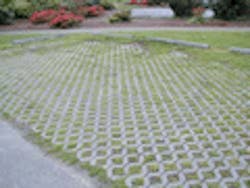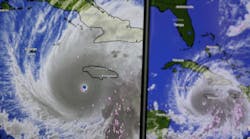Porous Parking Lots put Storm Water in its Place
The side parking lot at the Freeport (Maine) Community Center looks a lot like all the other lots around town -- until it rains.
While water puddles up on the other lots and then runs off, it leaks right through this one. Even the contents of a 5-gal. bucket disappear without a trace, according to a recent story in the Portland Press Herald.
"Literally, the water just goes right through," said Karen Young, director of the Casco Bay Estuary Partnership, which hopes to start a trend with the Freeport lot.
Porous pavement is one of the newest tools in Maine's efforts to control storm water and polluted runoff. The community center lot in Freeport is one of two southern Maine parking lots designed and built this summer using the flow-through asphalt. The other is a small parking area next to the Spurwink River in Scarborough.
"These are technologies that have been used in other parts of the world and the United States, but they are really new to Maine," Young said.
Porous asphalt has been around for decades. It covers highways in the southern United States and in Europe, offering a road surface that's puddle-free, as well as quieter. The pavement absorbs sound as well as water.
New England has been slower to spread the stuff around, partly because of concerns about how it would function in colder climates with deep freezes. It also can't be covered with sand to melt ice in winter, because that could clog up the pavement's pores.
But interest in new "green" building technology and a statewide assault on pollution from storm water runoff are generating interest here.
Storm water that washes chemicals, trash and sediment off of parking lots and roads into storms drains and streams is considered the No. 1 pollution threat to Maine's waterways, including Casco Bay.
Porous asphalt is basically blacktop made without sand or fine particles. That leaves air spaces to drain water.
Asphalt plants also add different polymers to hold it together, but it ends up looking like the undercoating of a regular roadway.
"The pavement is just the surface treatment -- the icing on the cake. What happens under the surface is" the key, said Zach Henderson of Hillier and Associates, an Augusta-based environmental design firm that worked on the Freeport project.
Beneath the pavement is about 2 feet or more of clean stones. In some cases, such as in Scarborough, the water simply is allowed to drain through the stones into the ground beneath the lot. In others, such as the Freeport lot, there are deeper trenches and perforated drainpipes to collect and direct storm water.
Officials in Freeport wanted to incorporate low-impact, or "green," building features. They got a grant for $28,000 from the Casco Bay Estuary Partnership to install the lot, which seems to be performing as advertised.
"There was a huge rainstorm and I went down to look at it," said Jim Cassida, a member of the community center building committee. "There was no standing water."
In Scarborough, the Rachel Carson National Wildlife Refuge wanted to keep storm water from continuing to run off a dirt road and polluting the river. "Our business is wildlife habitat," said Ward Feurt, refuge manager.
Both lots were paved in August, which allowed Pike Industries of Westbrook to make one larger batch of the specially mixed asphalt.
The porous material is not cheap, because it requires a separate mixing process. Conventional pavement costs about $3 a foot, while porous asphalt costs about $8 or $9 a foot, Henderson said. The stone base also is more expensive -- about $14 a ton, compared to about $7 a ton for a regular base.
Cassida said a conventional lot at the community center that let storm water drain off into the neighbor's yard might have cost only about $6,000, not $28,000.
There may be cost savings in the long run, however, especially if the technology helps avoid the construction of some other storm water containment system such as retention ponds. Advocates also say that, despite the regional resistance, it may be easier to maintain in winter because melted snow drains through rather than puddling and freezing.
The upfront cost is likely to limit its uses, at least for a while, Henderson said. But he's already talking to communities and organizations about porous pavement projects for next summer.
The Freeport Community Center lot already is generating more interest, said Young, at the Casco Bay Estuary Partnership. "It seems like it's catching on. In the beginning, we were really hunting down potential projects, and now we're getting more and more people approaching us."
Source: PPH


